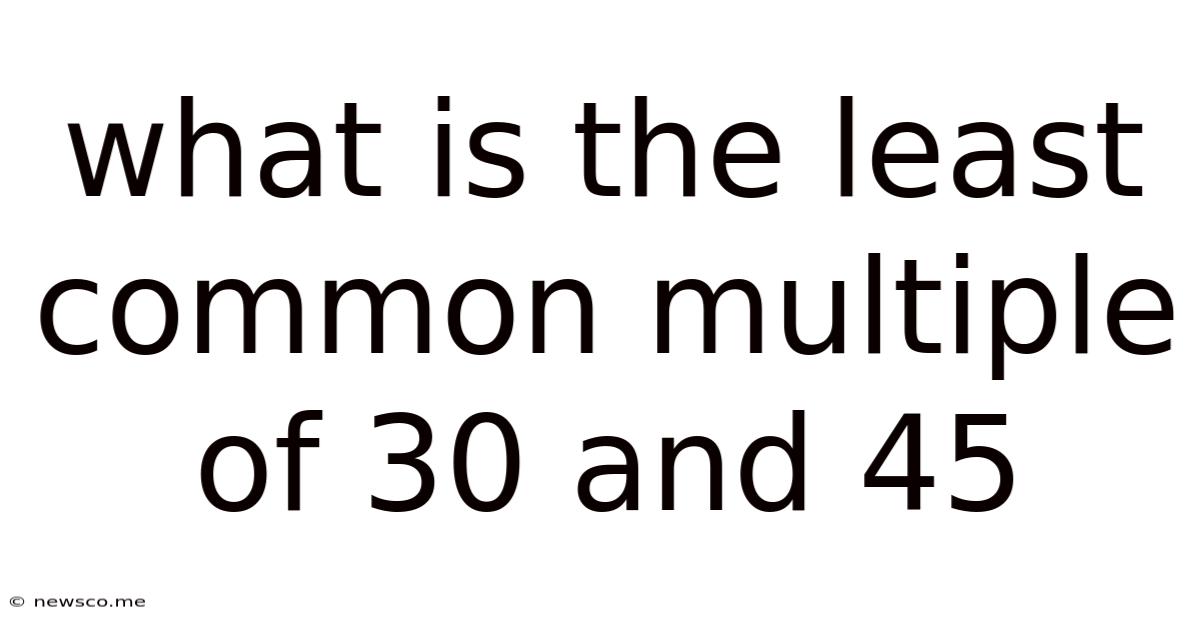What Is The Least Common Multiple Of 30 And 45
News Co
Mar 28, 2025 · 4 min read

Table of Contents
What is the Least Common Multiple (LCM) of 30 and 45? A Deep Dive into Finding LCMs
Finding the least common multiple (LCM) might seem like a simple arithmetic task, but understanding the underlying principles and different methods for calculation is crucial for various mathematical applications. This comprehensive guide will explore the concept of LCM, focusing specifically on finding the LCM of 30 and 45, while also providing broader strategies applicable to any pair of numbers. We will delve into different approaches, including prime factorization, the listing method, and using the greatest common divisor (GCD).
Understanding Least Common Multiples
The least common multiple (LCM) of two or more integers is the smallest positive integer that is divisible by all the integers without leaving a remainder. It's a fundamental concept in number theory with wide applications in various fields, including:
- Fractions: Finding a common denominator when adding or subtracting fractions.
- Scheduling: Determining when events will occur simultaneously (e.g., buses arriving at a stop).
- Modular arithmetic: Solving problems involving congruences.
- Abstract algebra: Defining structures and relationships in more advanced mathematical contexts.
Methods for Finding the LCM of 30 and 45
Let's explore different methods to determine the LCM of 30 and 45:
1. Prime Factorization Method
This method is arguably the most efficient and widely used for finding the LCM of larger numbers. It involves breaking down each number into its prime factors.
Step 1: Prime Factorization of 30
30 can be factored as follows:
30 = 2 x 3 x 5
Step 2: Prime Factorization of 45
45 can be factored as follows:
45 = 3 x 3 x 5 = 3² x 5
Step 3: Identifying Common and Unique Prime Factors
Comparing the prime factorizations of 30 and 45, we identify the common and unique prime factors:
- Common: 3 and 5
- Unique to 30: 2
- Unique to 45: 3
Step 4: Calculating the LCM
To calculate the LCM, we take the highest power of each prime factor present in either factorization and multiply them together:
LCM(30, 45) = 2 x 3² x 5 = 2 x 9 x 5 = 90
Therefore, the least common multiple of 30 and 45 is 90.
2. Listing Multiples Method
This method involves listing the multiples of each number until a common multiple is found. While effective for smaller numbers, it becomes less practical as the numbers get larger.
Step 1: Listing Multiples of 30
Multiples of 30: 30, 60, 90, 120, 150, 180...
Step 2: Listing Multiples of 45
Multiples of 45: 45, 90, 135, 180...
Step 3: Identifying the Least Common Multiple
By comparing the lists, we can see that the smallest common multiple is 90.
This method is straightforward but can be time-consuming for larger numbers.
3. Using the Greatest Common Divisor (GCD)
The LCM and GCD of two numbers are related through a simple formula:
LCM(a, b) = (|a x b|) / GCD(a, b)
where |a x b| represents the absolute value of the product of 'a' and 'b'.
Step 1: Finding the GCD of 30 and 45
We can use the Euclidean algorithm to find the GCD:
- 45 = 1 x 30 + 15
- 30 = 2 x 15 + 0
The GCD is 15.
Step 2: Calculating the LCM
Using the formula:
LCM(30, 45) = (30 x 45) / 15 = 1350 / 15 = 90
Therefore, the LCM of 30 and 45 is again 90.
Applications of LCM
The LCM finds applications in various real-world scenarios:
-
Scheduling: Imagine two buses, one arriving every 30 minutes and the other every 45 minutes. The LCM (90 minutes) tells us when both buses will arrive at the stop simultaneously.
-
Fraction Addition/Subtraction: To add fractions like 1/30 and 1/45, we need a common denominator, which is the LCM of 30 and 45 (90). We would rewrite the fractions as 3/90 and 2/90 respectively, making addition/subtraction straightforward.
Expanding the Concept: LCM of More Than Two Numbers
The principles discussed above can be extended to find the LCM of more than two numbers. For example, to find the LCM of 30, 45, and 60:
-
Prime Factorize Each Number:
- 30 = 2 x 3 x 5
- 45 = 3² x 5
- 60 = 2² x 3 x 5
-
Identify Highest Powers: The highest power of each prime factor is: 2², 3², and 5.
-
Calculate LCM: LCM(30, 45, 60) = 2² x 3² x 5 = 4 x 9 x 5 = 180
Conclusion: Mastering LCM Calculations
Understanding and efficiently calculating the least common multiple is a fundamental skill in mathematics with practical applications in various fields. The prime factorization method offers the most efficient approach for larger numbers, while the listing method serves as a useful tool for smaller numbers and provides a visual understanding of the concept. The relationship between LCM and GCD provides an alternative and often faster calculation method. By mastering these techniques, you can confidently tackle LCM problems and apply this crucial concept to a variety of mathematical challenges. Remember to always choose the method most suitable to the numbers involved to optimize your calculation process. The LCM, seemingly a simple concept, unveils the intricate beauty of number theory and its profound impact on various aspects of our quantitative world.
Latest Posts
Related Post
Thank you for visiting our website which covers about What Is The Least Common Multiple Of 30 And 45 . We hope the information provided has been useful to you. Feel free to contact us if you have any questions or need further assistance. See you next time and don't miss to bookmark.